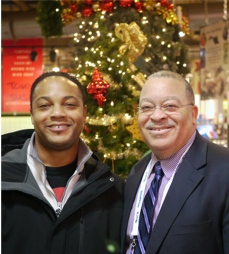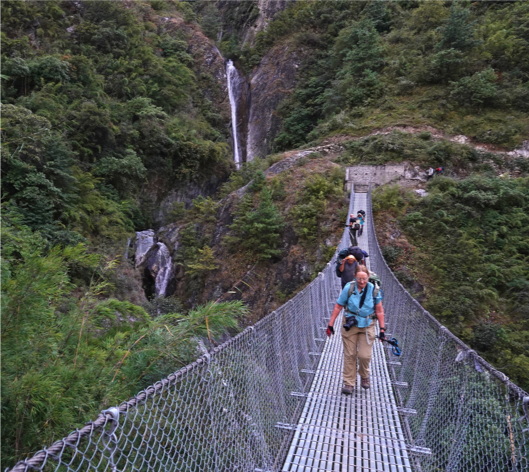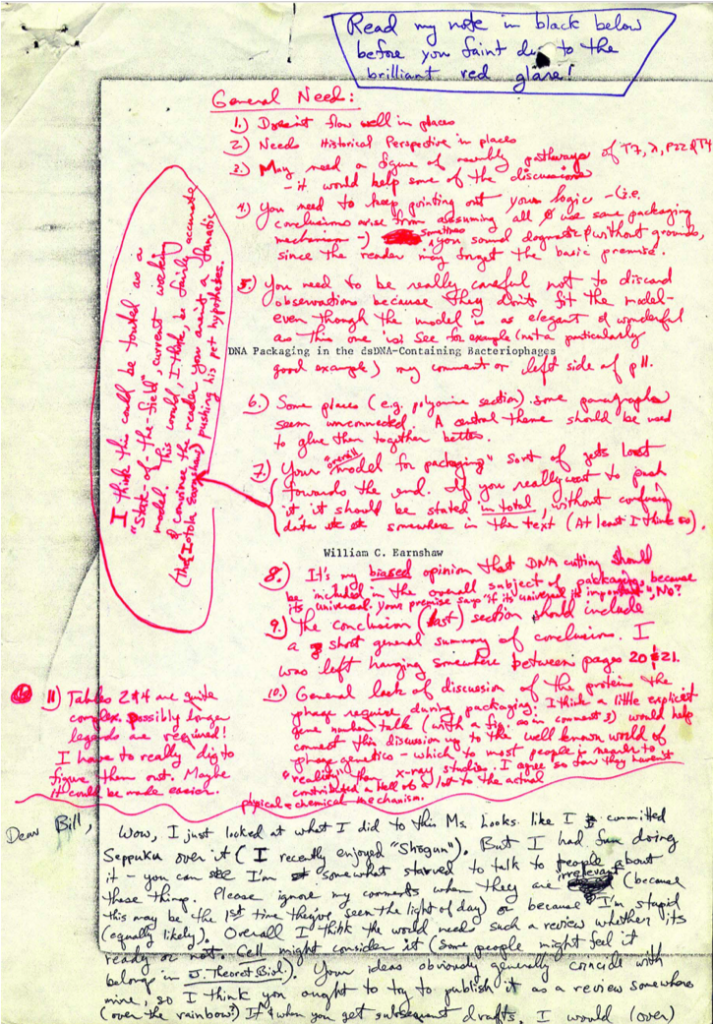Revealing the Molecular Organization of the P22 Procapsid and Mature Capsid
William C. Earnshaw, Ph.D., FRS, FRSE, FMedSci
Professor and Wellcome Principal Research Fellow
Wellcome Centre for Cell Biology
University of Edinburgh, ICB
Michael Swann Building, King’s Buildings
Max Bom Crescent, Edinburgh EH9 3BF
Scotland, UK
Bill.Earnshaw@ed.ac.uk
I didn’t apply to MIT to work with Jon. In fact, during my liberal arts education, I had never heard of bacteriophages T4 or P22. Instead, I applied because I was not sure if science was the career for me. My thinking was that if the science did not work out, then I would try to work with the person who up until then had given the most inspiring lecture that I had ever attended: the visionary photographer Minor White. He was in the Architecture department at MIT. I had spent more time in the darkroom than the teaching labs during my years at Colby College.
I arrived at MIT in January after spending 3 months in the US Air Force, where, having been classified as a biochemist, I worked with the Dr. Eiji Fujimori on the visual pigment rhodopsin. Dr. Fujimori had cycled out of Tokyo during World War II to get food for his family during the bombing of Tokyo, and now he worked for the US Air Force. Another small introduction to the weirdness of the world.
Anyhow, I turned up in January just as each MIT Biology faculty member was giving their annual pitch to the incoming Ph.D. students. There, I heard the second most influential lecture of my life – given by Jon. Up until that point, I had thought that I might work for Bob Weinberg, who was trying to attract his first Ph.D. student, but Jon changed all that. His lecture opened up a whole new world to me – the world of self-assembly – and that world has dominated my scientific life since then. Indeed, a major reason why Tom Pollard and I have so greatly enjoyed collaborating on our textbook “Cell Biology” over the last 25 years is because of a shared appreciation of assembly processes in biology that started for me with that lecture by Jon.
MIT was a terrifying place for me. And I don’t only mean terrifying in the literal sense – which it certainly was if you were riding in the back seat of a car driven by Sam Kayman. I was completely overwhelmed and lost. All of the other students had already mastered the game of associating scientific advances with the names of people who they all had heard of, but who were completely unknown to me. I was also useless at math and had to take remedial calculus at the same time as I took the terrifying 5.60 chemical equilibrium course (which I was sure that I would never pass) in order to be able to work out the equations. And MIT was tough! How could I ever forget the time when I went into David Botstein’s lab to ask hm a question about an experiment that I was supposed to design for Ethan Signer’s course? He told me to wait a minute and then gathered together his lab members, who included postdocs like Nancy Kleckner. He then had me repeat my question. His response was a 5-minute discourse on why it was a stupid, misguided question.
But I survived the hazing and the horrible courses and even the super-terrifying preliminary exams. Friendship was huge part of it. Sam and his wife Deb never managed to convince me that New York was anything other than a dark hole of evil violence and capitalist exploitation. But closer to home, I developed life-long friendships with Jerry Bryant and Minx Fuller, who joined the lab after I did. Jerry and Earnestine spent some great evenings with Katy and me in the Eastgate apartments where we played cards and discussed his passion for “direct to disc” recordings. We also hosted two awesome parties up in the top of the Eastgate as a collaboration between the Black Students association (I don’t remember what it was called) and the King lab. Those parties really rocked! The photograph shows Jerry and Jason at lunch at the American Society for Cell Biology meeting in Philadelphia in 2010.

Minx has had many more adventures than I. Most recently, we trekked with friends around Manaslu in the Himalayas in 2018 (the photo shows her crossing one of many very bouncy bridges).

My time in the lab was not always easy politically. I felt that Jon thought that I was an upper-class WASP because I went to a prep school (the Lenox School) and to a liberal arts college. But my father would not send me to Lenox because of his political views (he spearheaded an ultimately successful effort to get a regional high school for southern Berkshire County). So my mother Ruth stayed up nights sewing curtains piece-meal for Country Curtains to make the money for my Lenox tuition. I still remember lying in bed listening to her sewing machine going late into the night.
A really important breakthrough came early, when I took a course with Steve Harrison and Don Wiley at Harvard on biological structures together with another student – David Anderson. David had an MGB and he used to drive us there. We would then race back to MIT after the class so that I could sprint into the 5.60 lecture just as it was beginning. Amazingly, it worked – just barely – every time. Jon had set me the research problem of trying to understand the organisation of the P22 prohead with its assembly core of gp8 and shell of gp5. I was trying to determine whether the shell was internal or not by fixed-angle shadowing and electron microscopy, but when I heard Steve talk about small-angle x-ray diffraction of tomato bushy stunt virus, I realised that this was the method I needed. I asked Jon if I could work with Steve, and he agreed to have a meeting to discuss a possible collaboration. My recollection of this is having my heart sink as the two of them seemed to be shouting at one another and I could see the project going down the drain. Apparently, this was only an energetic discussion, and the project was given the green light.
The result was that I spent much of my Ph.D. on the T back and forth between MIT, where I would make the samples, and the Gibbs Lab at Harvard, where I would analyse them. This resulted in a number of insights into the packing of DNA inside bacteriophage heads. Also a very memorable lesson sitting beside Steve where I got a master class in how to guide a student through the process of designing a discussion so that it felt like they retained some ownership of it. But then Jon taught me another lesson. How many group leaders that you know would have their student publish a lead article in Nature, and say that they did not need to be a co-author because they felt that their contribution was not sufficient? I took that for granted then, but it blows me away now. And then, when a follow-up paper was going into Cell, Jon actually asked me if I minded having him as a co-author when the key to most of the work was electron microscopy that I had done in his lab! A lot to learn there about scientific honour and unselfishness.
The independence and scientific rigour really paid off when I went to the MRC-LMB in Cambridge as a postdoc – nominally with Aaron Klug, but actually with Tony Crowther and Ron Laskey. There you had to be able to work completely independently to thrive, and that was perfect for me. It wasn’t so easy when I moved on to a second postdoc with Uli Laemmli in Geneva. He was used to close management of his lab members, and this didn’t work well for us. But Uli taught me how to isolate and image mitotic chromosomes, and this has remained my passion for the rest of my life. You can learn a bit about how it has gone on our lab web page: https://www.earnshawlab.com.

I have such rich memories of that time at MIT that I could go on far too long. I’ll close with a pictorial example of just how interactive and intellectually alive the atmosphere around Jon was. After I had been a couple of years at the LMB as a postdoc, I decided to write a review on DNA packaging in bacteriophage. I sent it to Sherwood Casjens for comments. (Sherwood and Peter Berget were the King-lab postdocs who showed the wild young students how more “normal” people could excel at science.) Sherwood sent it back, with a “few” comments and I include the first page here. This was the kind of intellectual involvement that is priceless, and that only comes with a true love of science. And that we shared so often in Jon’s lab. Of course, there was no response possible other than to ask Sherwood if he would agree to co-author the review, which came out in Cell.
Jon took a real chance accepting a young wild student who was not very well trained and did not share his political involvement. I will forever be grateful that he did, because the education that I experienced during those years in Jon’s lab was beyond price. I have tried to pass at least some of his values on to those students and postdocs who have trained with me. I hope that I have succeeded and that Jon looks back with some satisfaction on the part he played in my scientific development.

